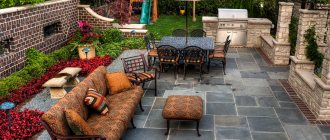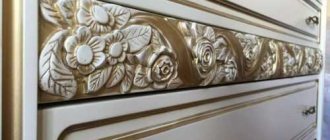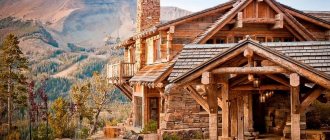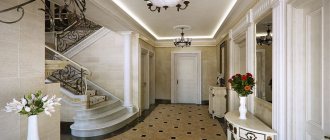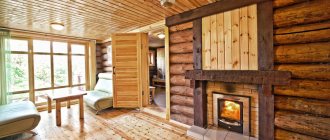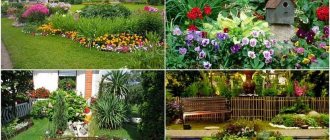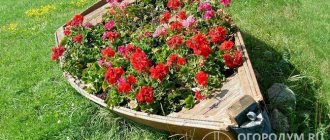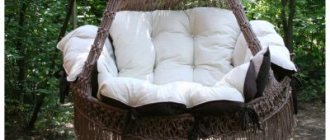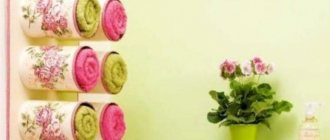The Russian hut has always been nice, solid and original. Its architecture testifies to its fidelity to centuries-old traditions, their durability and uniqueness. Its layout, design and interior decoration were created over many years. Not many traditional Russian houses have survived to this day, but you can still find them in some regions.
Initially, huts in Russia were built from wood, with their foundations partially buried underground. This ensured greater reliability and durability of the structure. Most often there was only one room, which the owners divided into several separate parts. An obligatory part of the Russian hut was the stove corner, to separate which a curtain was used. In addition, separate areas were allocated for men and women. All corners in the house were lined up in accordance with the cardinal directions, and the most important among them was the eastern (red), where the family organized an iconostasis. It was the icons that guests were supposed to pay attention to immediately after entering the hut.
Porch of a Russian hut
The architecture of the porch has always been carefully thought out; the owners of the house devoted a lot of time to it. It combined excellent artistic taste, centuries-old traditions and the ingenuity of the architects. It was the porch that connected the hut with the street and was open to all guests or passers-by. Interestingly, the whole family, as well as neighbors, often gathered on the porch in the evenings after hard work. Here the guests and owners of the house danced, sang songs, and children ran and frolicked.
In different regions of Russia, the shape and size of the porch were radically different. So, in the north of the country it was quite high and large, and the southern facade of the house was chosen for installation. Thanks to this asymmetrical placement and the unique architecture of the facade, the whole house looked very unique and beautiful. It was also quite common to see porches placed on pillars and decorated with openwork wooden posts. They were a real decoration of the house, making its facade even more serious and solid.
In the south of Russia, porches were installed from the front of the house, attracting the attention of passers-by and neighbors with openwork carvings. They could be either two steps or with a whole staircase. Some home owners decorated their porch with an awning, while others left it open.
Features of the interior of a village house inside
Village houses differ depending on what territorial area they are located in and what culture they belong to. For example, the decoration of a village house in the Siberian outback will be significantly different from the hut of residents of the south of Russia.
And a traditional Japanese house is incomparable to the provincial style of a French village.
The common features of all rural houses are the naturalness of materials, simplicity of decoration and hand-made household and decorative items. Most often, arts and crafts items were used, since any item, even the most exquisite, for example, a knitted tablecloth or embroidered towels, had a very practical use.
In Russian village houses, which were located in forest areas, the house itself, pieces of furniture: beds, tables, benches and chests were made of strong, durable wood.
In mountainous areas, solidity was emphasized in the design of the house and in the interior using stone.
Seni
In order to retain the maximum amount of heat from the stove in the house, the owners separated the living area from the street. The canopy is exactly the space that guests immediately saw when entering the hut. In addition to keeping warm, canopies were also used to store rockers and other necessary things; this is where many people made storage rooms for food.
A high threshold was also made to separate the entryway and the heated living area. It was made to prevent cold from entering the house. In addition, according to centuries-old traditions, each guest had to bow at the entrance to the hut, and it was impossible to go inside without bowing before the high threshold. Otherwise, the guest simply hit the doorframe naked.
Russian stove
The life of a Russian hut revolved around the stove. It served as a place for cooking, relaxation, heating and even bathing procedures. There were steps leading up, and there were niches in the walls for various utensils. The firebox was always with iron barriers. The structure of the Russian stove - the heart of any hut - is surprisingly functional.
The stove in traditional Russian huts was always located in the main area, to the right or left of the entrance. It was considered the main element of the house, since they cooked food on the stove, slept, and heated the entire house. It has been proven that food cooked in the oven is the healthiest, since it retains all the beneficial vitamins.
Since ancient times, many beliefs have been associated with the stove. Our ancestors believed that it was on the stove that the brownie lived. The garbage was never taken out of the hut, but burned in the oven. People believed that this way all the energy remained in the house, which helped increase the family’s wealth. It is interesting that in some regions of Russia they steamed and washed in the oven, and were also used to treat serious diseases. Doctors of that time claimed that the disease could be cured simply by lying on the stove for several hours.
Frivolous attitude
If you don’t want to spend time in an environment reminiscent of a museum or souvenir shop, bring only a touch of recognition through associations, and perhaps stereotypes. Numerous decorative items made from modern materials allow you to effectively fit them into almost any interior. A mirror framed with a baguette imitating wooden frames is appropriate for a loft and a true Russian style.
Bast shoes, nesting dolls, samovars, birch bark are recognizable always and everywhere. Create “a la Russe” only through ancient accents and folklore motifs - why not? Many designers reject this concept, considering it too deliberate and filled with cliches. But there is nothing wrong with souvenirs if they reflect your mood, impressions, perhaps memories of pleasant moments or interesting trips.
It is not necessary to recreate “literally” any one era, although there are distinctive features from a historical point of view:
| era | Name | Signs |
| The oldest Slavic heritage | Russian hut | Benches, chests, grips, ritual symbols in ornament, Red Corner |
| Times of Ivan the Terrible | Royal chambers, princely tower | Vaulted ceilings, stone, frescoes, four-poster bed, brocade |
| The first Romanovs | Palace Baroque | Chairs, gold and silver, stained glass |
| Peter's time | Baroque, Rococo | Enfilades, symmetry, unusual materials, Chinese motifs, porcelain |
| Catherine | Russian classicism | Libraries, art galleries |
Khokhloma, Gzhel - being expressive and original in themselves, are not considered fashionable unless special conditions are created for them - an unusual place of reproduction, non-standard art objects. The main thing is not to overdo it with their quantity and color compatibility with the rest of the environment.
Stove corner
It was also called the “woman’s corner” because all the kitchen utensils were located there. It was separated by a curtain or even a wooden partition. Men from their family almost never came here. A huge insult to the owners of the house was the arrival of a strange man behind the curtain in the corner of the stove.
Here women washed and dried things, cooked food, treated children and told fortunes. Almost every woman did needlework, and the quietest and most comfortable place for this was the stove corner. Embroidery, sewing, and painting were the most popular types of needlework for girls and women of that time.
Benches in the hut
In the Russian hut there were movable and fixed benches, and chairs began to appear in the 19th century. Along the walls of the house, the owners installed fixed benches, which were secured using supplies or legs with carved elements. The stand could be flat or tapered towards the middle; its decoration often included carved patterns and traditional ornaments.
There were also mobile benches in each house. Such benches had four legs or were installed on solid boards. The backs were often made so that they could be thrown over the opposite edge of the bench, and carved decor was used for decoration. The bench was always made longer than the table, and was also often covered with thick fabric.
Where is it appropriate?
It is unrealistic to make a completely Russian hut in an apartment. Externally there can be no talk of this; inside there will only be some kind of stylization. Apartment owners will be able to add some directional features; many stop there. They decide to waste time on completely stylizing their home.
This is suitable for a log house in the interior. In this type of housing it is appropriate to place familiar elements. No one forbids using it in the interior of a wooden house; the inside will look quite harmonious.
Russian style is more suitable for wooden houses
Russian style in the bedroom interior will look very harmonious
See alsoZoning a room into a bedroom and living room
Men's corner (Konik)
It was located to the right of the entrance. There was always a wide bench, which was fenced on both sides with wooden boards. They were carved in the shape of a horse's head, which is why the male corner is often called “konik”. Under the bench, men stored their tools intended for repairs and other men's work. In this corner, men repaired shoes and utensils, and also wove baskets and other products from wicker.
All the guests who came to the owners of the house for a short time sat down on the bench in the men's corner. It was here that the man slept and rested.
Women's corner (Seda)
This was an important space in a woman’s life, since it was from behind the stove curtain that the girl came out during the viewing party in elegant attire, and also waited for the groom on the wedding day. Here women gave birth to children and fed them away from prying eyes, hiding behind a curtain.
Also, it was in the women's corner of the house of the guy she liked that the girl had to hide the sweeper in order to get married soon. They believed that such a sweeper would help the daughter-in-law quickly become friends with her mother-in-law and become a good housewife in her new home.
Red corner
This is the brightest and most important corner, since it was considered a sacred place in the house. According to tradition, during construction, he was allocated a place on the eastern side, where two adjacent windows form a corner, so the light falls, making the corner the brightest place in the hut. Icons and embroidered towels always hung here, as well as in some huts - the faces of ancestors. Be sure to set up a large table in the red corner and eat food. Freshly baked bread was always kept under icons and towels.
To this day, some traditions associated with the table are known. So, it is not advisable for young people to sit on the corner in order to start a family in the future. It is bad luck to leave dirty dishes on the table or sit on it.
People stored cereals, flour and other products in hay barns. Thanks to this, the housewife could always quickly prepare food from fresh ingredients. In addition, additional buildings were provided: a cellar for storing vegetables and fruits in winter, a barn for livestock and separate structures for hay.
Creating the style of an old wooden manor
A simple peasant hut and a rich old estate have much in common: the predominance of wood in the interior, the presence of a huge stove (in the estate it is always lined with tiles), a red corner with icons and candles, and textiles made of linen and lace.
House in Russian style. Designer: Derevleva Olga
However, there were also numerous differences. The rich actively borrowed something new from foreign styles. These are, for example, bright upholstery of upholstered furniture, porcelain plates and clocks on the walls, elegant wooden furniture in English or French style, lampshades and sconces, paintings on the walls. In an interior in the style of a Russian mansion, stained glass windows will be very useful as interior windows, partitions or veranda glazing. In a word, everything here is quite simple, like in a hut, but there is a slight touch of luxury.
In the style of a Russian estate
